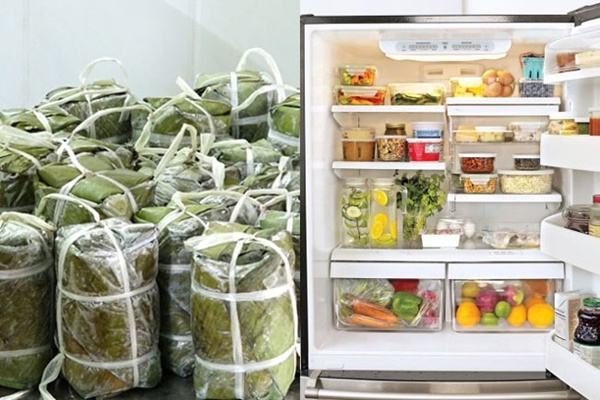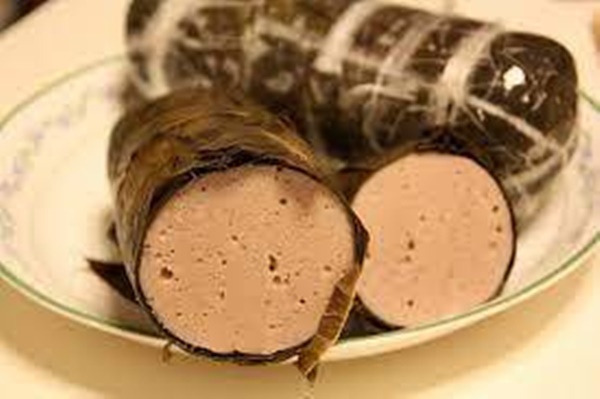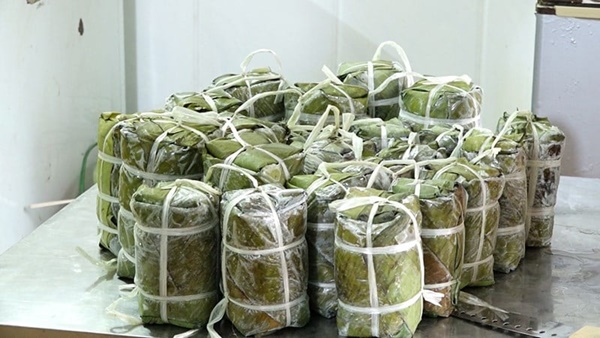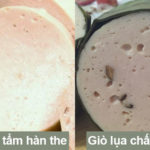Storing Vietnamese Pork Sausage (Giò Lụa)
To properly store Vietnamese pork sausage, it is recommended to use a zip lock bag or food wrap to tightly seal the sausage. If it hasn’t been opened yet, keep the original packaging intact and store it in the chiller at a temperature of 5 – 8 degrees Celsius.
With this storage method, you can keep partially cut sausage for 1 – 3 days. Intact sausage in its original packaging can be stored in the chiller for up to 6 days. However, always check the specific storage instructions and expiration date printed on the packaging by the manufacturer.
If you need to use the sausage immediately, you can quickly defrost it by wrapping it in plastic wrap and soaking it in cold water for about an hour. Make sure that no water seeps into the sausage during this process.

Freezing in the Freezer
Storing the sausage in the freezer is the best way to prolong its shelf life, and it can last up to 10 – 20 days. Similar to storing it in the chiller, make sure to tightly wrap the sausage before placing it in the freezer.
For partially used sausage, place it in a zip lock bag, then put it in an airtight container and store it in the freezer. It can be kept this way for up to 6 days. When using frozen sausage, it is recommended to defrost it slowly in the chiller compartment of your refrigerator or at room temperature.
If you need to defrost it more quickly, tightly wrap the sausage and soak it in a bowl of cold water for about an hour. Avoid letting water seep into the sausage as it may affect the flavor.
To further extend the shelf life, you can boil the sausage again after thawing.

For pork ear sausage and stir-fried sausage (giò tai, giò xào), which cannot be boiled again, you will need to know how to remake them. Place the sausage and a small amount of water in a pot and heat it up. Once it’s cooled down, pour it into a mold and press it tightly. Wait until the sausage hardens, then remove it from the mold and store it in the refrigerator.
As a general rule, sausage and pâté can be stored for 4-6 days in the chiller compartment of your refrigerator. If you have purchased a large quantity, you can store it in the freezer for about 10 days.
When removing the sausage from the freezer, let it thaw at room temperature for about 4 hours or transfer it to the chiller compartment for 8 hours before using it.
To prevent bacteria from fresh food from contaminating the sausage and causing it to spoil, keep the sausage in a separate compartment, away from fresh food and strong-smelling items.
Do not store the sausage near the refrigerator door, as this area tends to have unstable temperatures which can cause the sausage to spoil.
Storing Without a Refrigerator
In the absence of a refrigerator and in relatively cool weather, you can store the sausage at room temperature in a dry, well-ventilated area. Avoid wrapping the sausage too tightly. If the weather is hot, consider using a bucket of ice to store the tightly wrapped sausage.

Alternatively, you can use a pot or stainless-steel basin. Place the sausage inside, cover it, and place the container in a basin of cold water. The cool water will help maintain the flavor and freshness of the sausage for about 2 – 3 days (for unopened sausage).
However, storing sausage without refrigeration will reduce its shelf life. After steaming the sausage, clean the outer layer and squeeze out the water from the banana leaves. Then, hang it in a dry and well-ventilated area, and it can be stored for 3 – 5 days. If the sausage has been cut, it is best to consume it on the same day.
Storing Pork Head Cheese (Giò Thủ)
For pork head cheese, whether homemade or purchased, it is best to store it in the refrigerator. To maintain its texture and flavor, wrap the pork head cheese in 2 – 3 layers of banana leaves, and then place it in a zip lock bag.
Store it in the chiller compartment, away from fresh food items, and consume it within 5 – 7 days. If the pork head cheese has been cut and partially used, transfer it to an airtight container or wrap it tightly in plastic wrap or a zip lock bag, and store it in the chiller compartment for 2 – 3 days.
Storing Pork Leg Sausage (Giò Bê) and Sour Pork Sausage (Giò Me)
How long can Giò Bê and Giò Me be stored?
Intact pork leg sausage and sour pork sausage can be stored in the refrigerator for 7 – 10 days. If the pork leg sausage has been sliced, it should be consumed within 3 – 4 days. To extend the shelf life, you can store them in the freezer for 10 – 15 days.
Proper Storage Methods for Giò Bê and Giò Me
For unopened pork leg sausage and sour pork sausage, keep the original packaging intact. If it is homemade, wrap it tightly in banana leaves and then an additional layer of food wrap, a zip lock bag, or plastic bag.
Store it in the chiller compartment at a temperature of 0 – 4 degrees Celsius, away from fresh food and strong-smelling items. For sliced pork leg sausage, place it in an airtight container or zip lock bag, seal it tightly, and store it in the chiller compartment.
Notes
It is advisable to purchase only the amount of sausage that can be consumed within the recommended storage period. Avoid wasting food by storing leftovers improperly.
Do not compromise your health by consuming sausage that exhibits unusual signs (odd smell, slimy texture, or mold). Always discard sausage that shows signs of spoilage.
According to Xe và Thể Thao
The Ultimate Guide to Storing Leftover Vietnamese Cold Cuts: How to Make Them Last and Taste Like New
Preserving food is essential, especially when it comes to delicacies like giò. While we all love indulging in this savory treat, eating too much can lead to boredom. However, improper storage can result in spoilage and waste. Each type of giò requires a unique preservation method, and we’re here to guide you through the process with our expert tips.
The Ultimate Guide to Buying Delicious Sausages for Tet: Four Tell-Tale Signs to Spot Quality.
To ensure your Lunar New Year feast is truly special, it’s essential to know how to differentiate between authentic and inferior Vietnamese pork sausage, or “giò lụa.” The ability to discern the presence of borax, a common additive, will empower you to choose only the finest sausage for your festive spread.
The Ultimate Guide to Sausage and Pork Roll Shopping: A Simple Test for Quality Assurance.
To purchase delicious and authentic giò lụa and chả, one needs to possess a certain ‘know-how’. It is essential to be able to discern the pure, traditional delicacies from those that are filled with unwanted additives and fillers. With this knowledge, you can ensure that you are enjoying the very best that Vietnamese cuisine has to offer.
How to Distinguish Between Pure and Contaminated Pork Sausage and Pork Roll
“Unravel the secrets to distinguishing between pure and impure pork delicacies. The tips and tricks we’re about to reveal will empower you to make informed choices for your health without compromising on taste. Prepare to become a master at selecting the finest and safest pork treats as we explore the art of recognizing quality giò chả.”





































